This post provides an overview of the exhibition Art on the Mind: Ten Years of Creative Aging, on view November 14, 2020–November 14, 2021, using the introduction, section overview, and label texts included in the exhibition.
Introduction

Years of Creative Aging, Frye Art Museum,
November 14, 2020
Many of us know or have known someone who is living with dementia, a condition in which people experience a shift in their perception of the world due to changes in the brain, with Alzheimer’s disease being the most common type. Individuals living with dementia have a wide spectrum of abilities and experiences, and the act of creating and discussing art introduces new forms of self-expression that meet different needs.
In the past decade, the Frye Art Museum has presented a variety of Creative Aging programs, including small-group experiences in the galleries and art studio, one-on-one art-making in care communities, and conferences and workshops on creativity, dementia, and healthy aging that bring together care professionals. Of note, many of the Museum’s Creative Aging programs offer arts engagement for people living with dementia and their care partners and can serve as a respite from daily challenges. With an emphasis on present-moment awareness, programs are designed to encourage creative exploration, experimentation, and playfulness. Through this approach, participants are able to sidestep cognitive limitations and enjoy a renewed sense of purpose, well-being, and connection with others, as documented in a 2015 study on the Frye Art Museum’s here:now program conducted by the University of Washington.
This exhibition shares stories and works of art that highlight the experiences of people living with dementia, their care partners, and those who help make the programs happen, including teaching artists, volunteers, and the Creative Aging Advisory Committee. Their experiences are testimony to the success of arts engagement programs in bringing joy, respect, and dignity to people living with dementia while destigmatizing the disease.
Art on the Mind: Ten Years of Creative Aging is organized by Mary Jane Knecht, Manager, Creative Aging Programs, and Michelle Cheng, Director of Education & Community Partnerships. Generous support for this exhibition is provided by the Richard and Maude Ferry Foundation, the Frye Foundation, and Frye Members.
Section Navigation
People | Process | Looking Ahead
People
Below, three Creative Aging program participants share their stories and experience.

Installation view: Jueqian Fang
Julia and Marybeth Blackburn

Julia (left) and Marybeth in the here:now pilot program in 2010. Photo: Jill Hardy
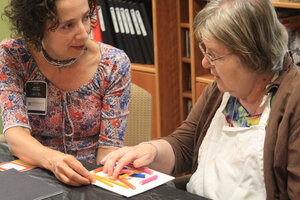
Volunteer Janet Fagan (left) and Julia in a Bridges program at Fred Lind Manor in spring 2019. Photo: Katherine Lamar
My older sister Julia has Lewy Body Dementia. Folks with this diagnosis exhibit fluctuating states of cognition. Care partners such as myself often break these down into three states: Good Times, Bad Times, and Showtimes.
My sister Julia and I have discovered a fourth state of being: we call it Frye Time.
Frye Time happens whenever we participate in a Frye program, whether it’s the gallery discussion tours, or a morning of Meet Me at the Movies. The hallmark of Frye Time is the sense that ‘Lewy’ has taken a break, stepped aside for a little while so that we can just be ourselves, two sisters enjoying each other’s company. These Frye sessions bring up shared memories and often lead to deeper conversations about our shared past.
In the relaxed, open space of Frye Time, my sister’s words come a little easier; her thoughts link one to another in a smooth braid. For that time, ‘Lewy’ is quiet and Julia speaks again.
Frye Time has been an integral part of our dementia journey, a bright light on a sometimes dark and difficult path.
–Marybeth Blackburn, care partner to her sister Julia Blackburn
Julia and Marybeth Blackburn have been a part of the Frye’s Creative Aging programs from the very beginning in 2010. They were a part of the pilot for here:now, a program that offers conversation-based gallery tours and studio art experiences, and have participated in many programs since.

These artworks, included in the exhibition, were created by Julia in the Bridges program at Fred Lind Manor during spring 2019.
Installation view: Jueqian Fang
Kay Grant Powers and Randy Rowland
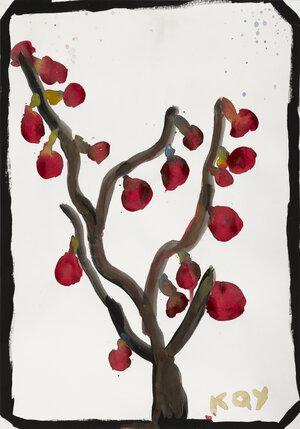
on paper. 17 x 12 in. Photo: Jueqian Fang
I’ll always remember our first visit. For what seemed like a long time, everyone just looked at the framed painting in front of us. Then the group’s leader asked us to talk about what we saw and how it made us feel. To my shock, Kay started waxing poetic, describing the painting in front of her. She was performing at an intellectual level I hadn’t seen in at least a couple years. I cried, and I was hooked.
–Randy Rowland, care partner to his wife Kay Grant Powers, shares his feedback on a here:now tour while discussing a painting in the Frye's Founding Collection.
Randy and Kay were avid participants of here:now gallery tours and art-making classes; Meet Me at the Movies, an interactive film program; and the Alzheimer’s Café and pre-café discussion. Kay passed in January 2019.
Brian and Anne O’Leary
It was always so uplifting to visit the Frye and be greeted by wonderful art and such a warm, supportive staff who made our time there so enriching. Such fun to focus on works of art and then go to the studio to be creative—each in our own way.
–Anne O’Leary, care partner to her husband Brian O’Leary
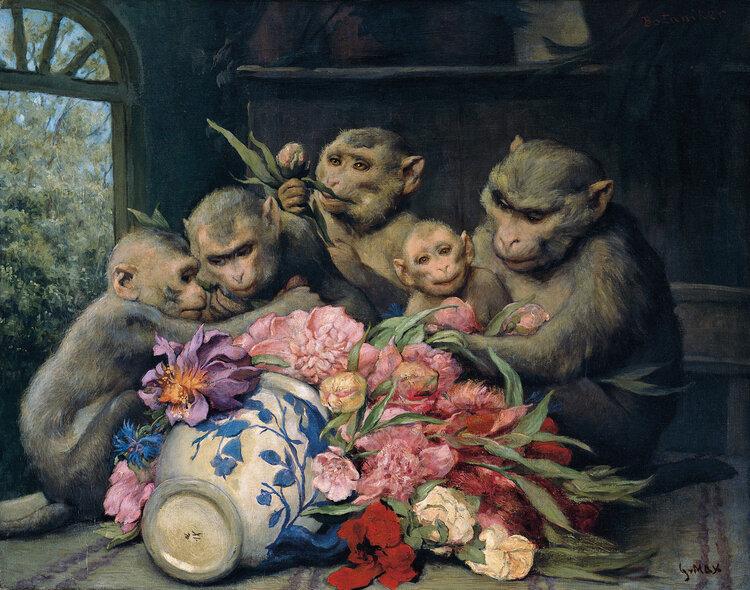
Gabriel von Max. Botaniker (The Botanists), ca. 1900–1915. Oil on canvas. 25 x 31 3/4 in. Frye Art Museum, Gift of Charles and Emma Frye, 1952.117. Photo: Eduardo Calderón
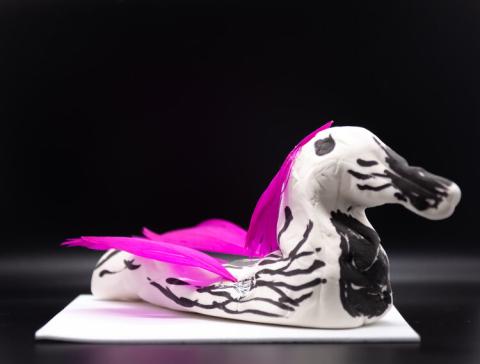
Anne O’Leary. Untitled, 2019. Sculpted Model Magic clay with marker ink, feathers, and beads on foam. 2 x 6 x 2 1⁄2 in. Photo: Heather Ratcliff

Brian O’Leary. Untitled, 2019. Sculpted Model Magic clay with marker ink, feathers, and beads on foam. 2 x 6 x 2 1⁄2 in. Photo: Heather Ratcliff
Anne and Brian O’Leary took part in a here:now class in fall 2019, during which they had the opportunity to view and discuss Botaniker by Gabriel von Max, a painting in the Frye’s Founding Collection. For the art-making activity, participants responded to the inquiry-based discussion by creating animals of their own in clay. Anne and Brian decided to create animals that are found near their home—in this case, a loon and an orca.
Process
“Dementia is a shift in the way a person experiences the world around them.”
— G. Allen Power, M.D., Keynote Speaker, 2016 Creative Aging Conference
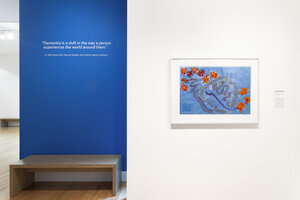
Installation view: Jueqian Fang

Kirsten Kinnan, Margot Hughes McDonald, and Emma Levitt Royer. Untitled, 2020. 36 x 24 in. Acrylic on paper, applied collaboratively in response to the rhythms of music. Photo: Jueqian Fang
The Creative Aging programs use not only the Frye Art Museum’s collection but also special exhibitions as inspiration for discussion and art-making techniques. For a here:now class in winter 2020, participants explored the theme of movement by looking at photographs and videos of Seattle-based choreographer and dancer Donald Byrd from the exhibitionThe America That Is To Be. After the gallery discussion, participants responded by creating this collaborative piece of art while listening to music.
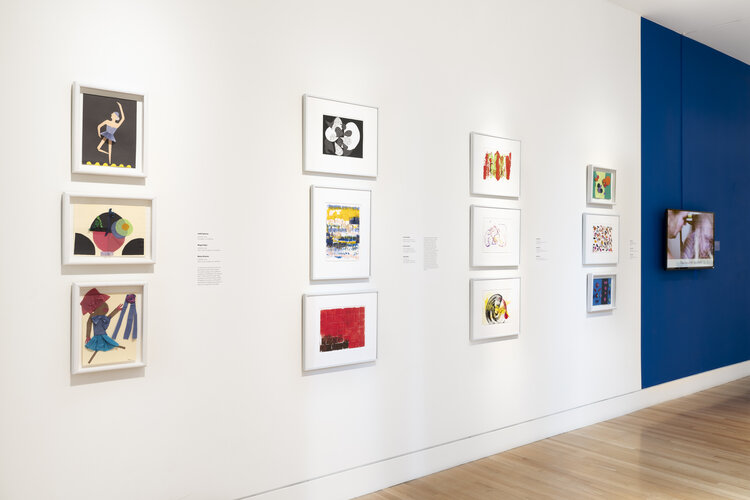
Installation view: Jueqian Fang
Art-making projects across the Creative Aging programs are designed to emphasize the tactility of working with different art mediums and creative decision-making. Such projects build self-confidence and foster a sense of play.
To create the three artworks pictured at left above, here:now participants explored the theme of costume design in two different exhibitions, Donald Byrd: The America That Is To Be and Dress Codes: Ellen Lesperance and Diane Simpson. After the gallery discussion, participants responded by designing costumes of their own using fabric and paper.
The grouping of nine artworks pictured at right above is a selection from a 2019 Bridges program at The Summit at First Hill, a local retirement community. Bridges provides art conversations and art-making for older adults, including those living with dementia who reside in care communities or private homes in the Seattle area. These particular artworks demonstrate a variety of materials and techniques that encourage creative exploration and experimentation with the one-on-one support of a teaching artist or trained volunteer.
Looking Ahead
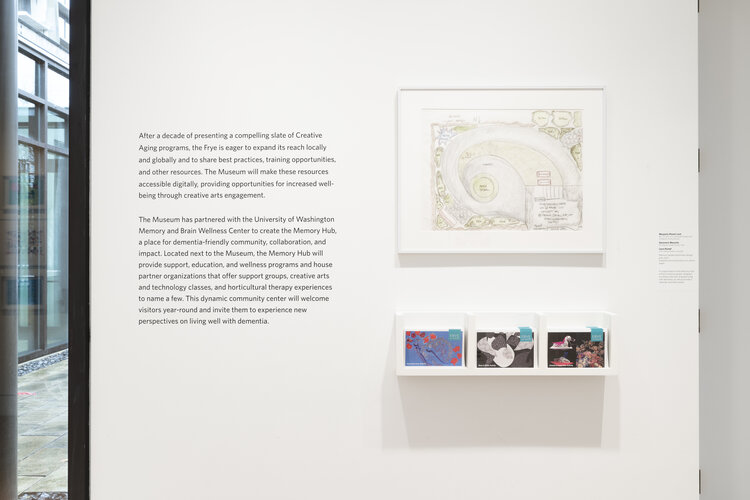
Installation view: Jueqian Fang
After a decade of presenting a compelling slate of Creative Aging programs, the Frye is eager to expand its reach locally and globally and to share best practices, training opportunities, and other resources. The Frye will make these resources accessible digitally, providing opportunities for increased well-being through creative arts engagement.
The Frye has partnered with the University of Washington Memory and Brain Wellness Center to create the Memory Hub, a place for dementia-friendly community, collaboration, and impact. Located next to the Museum, the Memory Hub will provide support, education, and wellness programs and house partner organizations that offer support groups, creative arts and technology classes, and horticultural therapy experiences, to name a few. This dynamic community center will welcome visitors year-round to experience new perspectives on living well with dementia.
A unique feature of the Memory Hub will be a memory garden, designed to enhance the lives of people living with dementia, providing a relaxing, restorative space.
Additional Exhibition Resources
The Frye hosted a virtual opening reception for Art on the Mind: Ten Years of Creative Aging on November 19, 2020, which featured a peek at the exhibition, a poetry reading, and reflections from community members on their experiences in the programs.
In Creative Aging, art-making projects are designed to emphasize creative decision-making and the tactile experience of working with different art mediums. Such projects build self-confidence and foster a sense of play for people living with dementia. These activities allow a care partner to encourage creative exploration and experimentation with a person living with dementia and provides an opportunity for both to discuss and make art. The exhibition includes three activity cards that visitors can take with them. You can also explore the activities on our blog:
Learn more about Creative Aging programs at the Frye.
